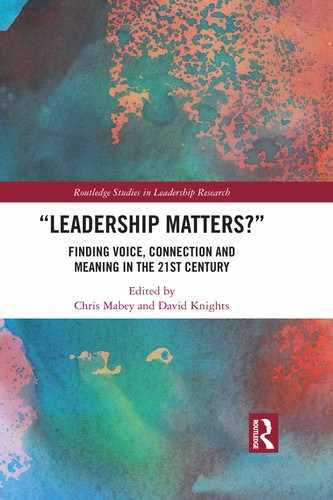Part II
Connection
Where Is Leadership in the Mundane?
In various ways, this section is concerned with recognizing and theorizing the disconnects between who we feel we are as human beings and who we are seemingly expected to be as workplace practitioners, leaders or followers. It is as much a focus on what resides in between the messy, visceral, flawed self and the clean, intellectual self that seems to be in-control of events and circumstances, our cultural and institutional assumptions. Each of the authors address disconnects between the privately experienced self and the publicly presented/expected self: a topic rarely surfaced in conventional leadership discourse.
David Knights challenges the dominant idea of applying individualistic, technical interventions and prescriptions to the problems of leadership. In its place, he advocates a theoretically informed yet practice-driven strategy that takes full account of how leadership is a collective and embodied process of interpersonal and intra-personal relationships the effectiveness of which depends strongly on affective engagement. He seeks to illustrate this through reflecting on some recent highly significant political and sporting events of international importance as also through a vignette outlining some personal experiences. He concludes that its affecting and being affected by joyful and creative productive action best encapsulates leadership.
Leah Tomkins and Peter Simpson highlight parallels between their private experiences of care and their public experiences of leadership. They relate the notion of leading with integrity to a desire for greater wholeness, by reconnecting some of their experiences across the so-called work-life boundary. Using examples from their own family and professional lives, they create a virtuous circle in which the emotional and decision-making dynamics of both care and leadership can be mutually illuminating. They speak honestly and personally about how not only do they learn how to care in the domestic situation from their experience of leading in organizations but also from the inverse of reflecting on their caring responsibilities when pursuing leadership tasks at work.
Hugo Gaggiotti notes that language—and the English language in particular—disconnects us in two ways. First, the lack of understanding that arises between people; in this case, Anglo-Saxon leadership development professionals and students for whom English is not their native language, and for whom “leadership” has odd and difficult resonances. A second disconnect is within the self—this is experienced when we have to engage with a topic that is so “foreignly” constructed that it gets in the way of a heartfelt, ethical and embodied engagement.
Tim Harle invokes the notion of “good enough” in exploring the fallible self and infallible self. His contention is that we often overlook the fact that ethical—and what might be termed great—leadership is actually exercised by ordinary people through a succession of everyday acts in mundane situations.
Another way of seeing this section is that of working with and through difference. When there are disconnections we not only become detached but also estranged from our experiences. So our minds become detached from our bodies, our thinking cuts us off from feelings and emotion, our sense of self loses touch with others on whom it is dependent, our work becomes separated from our lives and leading is in danger of elevating itself above its purpose. The provocation is that much of this goes unnoticed in the mundane and that some re-connections may help restore the ethical wholeness of our leadership as embodied and passionately engaged with life.
In the two vignettes at the end of this section, the contributors give some clues as to what this reconnection looks like in the everyday ordinariness of life. It is unlikely that either felt their “battles” were much to do with personal courage and leading ethically at the time, but, on reflection, both give very personal glimpses on what it means to be disconnected and how this might be dealt with.
Clare Rigg relates a story all too common in organizations… a middle manager caught in the crossfire between unreasonable demands of those in charge and the legitimate angst of those below. Despite strong core beliefs and a determination to make a difference, she ultimately decided that the best and ethical thing to do was “to step away rather than be caught up in continuing the dysfunction”.
The vignette from Catherine Turner-Perrott starts with a mother confronted by a child uninterested in food, a scenario that could not be further removed from the corporate world of ethics. Yet from these small beginnings unfolds a series of small steps, each incurring some risk and courage, the consequences of which are transforming her into an entrepreneurial leader in developing an organization inspired by ethical care that provides services to restaurants, cafes and canteens, rendering them more efficient and effective.
